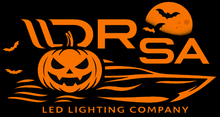What Is Average Rated Life?
Average Rated Life (ARL) is the industry term used to describe the expected lifespan of a lighting product. It represents the number of hours a bulb operates before half of a tested group stops performing within normal parameters.

In other words, if a batch of 100 bulbs is tested and 50 of them fail after 50,000 hours, the average rated life of that bulb is 50,000 hours. It’s a predictive benchmark that helps engineers, technicians, and boat owners understand how long their lighting systems will likely perform before replacement is needed.
How Average Rated Life Is Measured
ARL is determined through controlled laboratory testing where a sample group of bulbs runs continuously under standard voltage and temperature conditions. The test continues until 50% of the lamps fail or reach their defined lumen depreciation point.
While incandescent and fluorescent bulbs fail abruptly, LED lights degrade more slowly. Instead of suddenly going dark, LEDs gradually lose brightness over time. Because of this, LED ARL ratings are typically expressed using an “L” value that indicates lumen maintenance.

Here’s what those ratings mean:
-
L90 – The light retains 90% of its original brightness.
-
L80 – The light retains 80% of its original brightness.
-
L70 – The light retains 70% of its original brightness, which is often considered the end of its useful life.
For example, a Lumitec floodlight rated L70 at 50,000 hours means it will still produce 70% of its original output after 50,000 hours of operation often many years of real-world use aboard your vessel.
Typical Lifespan by Lighting Type

Different light technologies have widely varying lifespans depending on design, materials, and operating conditions.
| Type of Bulb | Average Rated Life (Hours) |
|---|---|
| LED | 40,000–60,000 |
| Fluorescent | 20,000–36,000 |
| HID (High-Intensity Discharge) | 10,000–24,000 |
| Compact Fluorescent (Plug-In) | 10,000–20,000 |
| Compact Fluorescent (Screw-In) | 8,000–10,000 |
| Halogen | 2,000–4,000 |
| Incandescent | 750–2,000 |
For comparison, modern marine LED lights from DRSA including deck lights, engine room fixtures, and underwater lights can last 25 times longer than incandescent lamps while consuming up to 80% less power.
Factors That Affect Average Rated Life
The rated life of a bulb is an estimate based on lab conditions. Real-world performance can vary depending on environmental factors and usage patterns. Common causes of early bulb failure include:
-
High operating temperature inside sealed housings or engine compartments
-
Voltage fluctuations from unstable power systems or generators
-
Moisture exposure from rain, seawater, or condensation
-
Frequent on/off switching that stresses electronic components
-
Shock or vibration, especially on vessels in rough water
-
Incorrect operating voltage, since even a 5% increase can cut lamp life in half
Using marine-rated LED lights designed for harsh conditions, like the DRSA Engine Room Light Collection, helps protect against these issues and extends overall system reliability.
Why Average Rated Life Matters for Marine Lighting
For boaters, ARL isn’t just a technical number; it’s a measure of reliability and safety. Long-lasting lights reduce maintenance intervals, minimize downtime, and help ensure that critical areas like decks, walkways, and cabins remain illuminated when you need them most.
Choosing LEDs with higher L-values (L80 or L90) ensures better lumen retention and stable color output over time, which is especially important for navigation lights, underwater fixtures, and dock lighting, where consistent brightness matters.
Example in a Sentence
“The new LED floodlight from DRSA has an average rated life of 50,000 hours, meaning it can run for years before reaching 70% of its original brightness.”
Synonyms: half-life, B50
Related Terms: voltage, operating voltage, lumen depreciation
Explore Long-Life Marine LED Lighting
Shop LED marine lighting systems at DRSA.com. From navigation and deck lights to cabin and underwater fixtures, every DRSA light is engineered for long life, high efficiency, and consistent performance in marine environments.
